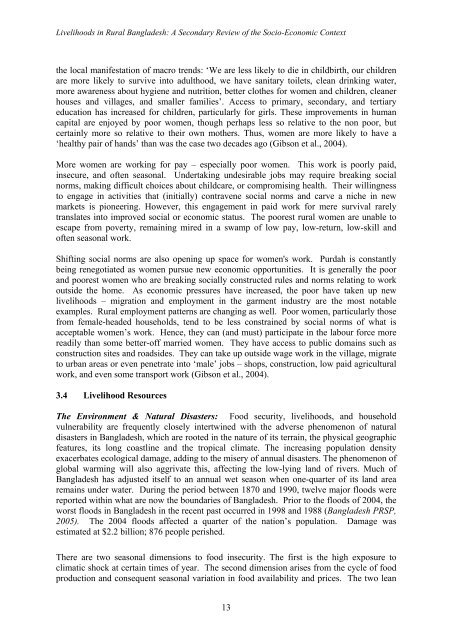RURAL BANGLADESH - PreventionWeb
RURAL BANGLADESH - PreventionWeb
RURAL BANGLADESH - PreventionWeb
You also want an ePaper? Increase the reach of your titles
YUMPU automatically turns print PDFs into web optimized ePapers that Google loves.
Livelihoods in Rural Bangladesh: A Secondary Review of the Socio-Economic Context<br />
the local manifestation of macro trends: ‘We are less likely to die in childbirth, our children<br />
are more likely to survive into adulthood, we have sanitary toilets, clean drinking water,<br />
more awareness about hygiene and nutrition, better clothes for women and children, cleaner<br />
houses and villages, and smaller families’. Access to primary, secondary, and tertiary<br />
education has increased for children, particularly for girls. These improvements in human<br />
capital are enjoyed by poor women, though perhaps less so relative to the non poor, but<br />
certainly more so relative to their own mothers. Thus, women are more likely to have a<br />
‘healthy pair of hands’ than was the case two decades ago (Gibson et al., 2004).<br />
More women are working for pay – especially poor women. This work is poorly paid,<br />
insecure, and often seasonal. Undertaking undesirable jobs may require breaking social<br />
norms, making difficult choices about childcare, or compromising health. Their willingness<br />
to engage in activities that (initially) contravene social norms and carve a niche in new<br />
markets is pioneering. However, this engagement in paid work for mere survival rarely<br />
translates into improved social or economic status. The poorest rural women are unable to<br />
escape from poverty, remaining mired in a swamp of low pay, low-return, low-skill and<br />
often seasonal work.<br />
Shifting social norms are also opening up space for women's work. Purdah is constantly<br />
being renegotiated as women pursue new economic opportunities. It is generally the poor<br />
and poorest women who are breaking socially constructed rules and norms relating to work<br />
outside the home. As economic pressures have increased, the poor have taken up new<br />
livelihoods – migration and employment in the garment industry are the most notable<br />
examples. Rural employment patterns are changing as well. Poor women, particularly those<br />
from female-headed households, tend to be less constrained by social norms of what is<br />
acceptable women’s work. Hence, they can (and must) participate in the labour force more<br />
readily than some better-off married women. They have access to public domains such as<br />
construction sites and roadsides. They can take up outside wage work in the village, migrate<br />
to urban areas or even penetrate into ‘male’ jobs – shops, construction, low paid agricultural<br />
work, and even some transport work (Gibson et al., 2004).<br />
3.4 Livelihood Resources<br />
The Environment & Natural Disasters: Food security, livelihoods, and household<br />
vulnerability are frequently closely intertwined with the adverse phenomenon of natural<br />
disasters in Bangladesh, which are rooted in the nature of its terrain, the physical geographic<br />
features, its long coastline and the tropical climate. The increasing population density<br />
exacerbates ecological damage, adding to the misery of annual disasters. The phenomenon of<br />
global warming will also aggrivate this, affecting the low-lying land of rivers. Much of<br />
Bangladesh has adjusted itself to an annual wet season when one-quarter of its land area<br />
remains under water. During the period between 1870 and 1990, twelve major floods were<br />
reported within what are now the boundaries of Bangladesh. Prior to the floods of 2004, the<br />
worst floods in Bangladesh in the recent past occurred in 1998 and 1988 (Bangladesh PRSP,<br />
2005). The 2004 floods affected a quarter of the nation’s population. Damage was<br />
estimated at $2.2 billion; 876 people perished.<br />
There are two seasonal dimensions to food insecurity. The first is the high exposure to<br />
climatic shock at certain times of year. The second dimension arises from the cycle of food<br />
production and consequent seasonal variation in food availability and prices. The two lean<br />
13












![View full document [PDF 988.55 KB] - PreventionWeb](https://img.yumpu.com/47733942/1/184x260/view-full-document-pdf-98855-kb-preventionweb.jpg?quality=85)
![View full document (in French) [PDF 4.96 MB] - PreventionWeb](https://img.yumpu.com/47223870/1/184x260/view-full-document-in-french-pdf-496-mb-preventionweb.jpg?quality=85)


![View full document [PDF 25.02 MB] - PreventionWeb](https://img.yumpu.com/44204570/1/190x234/view-full-document-pdf-2502-mb-preventionweb.jpg?quality=85)
